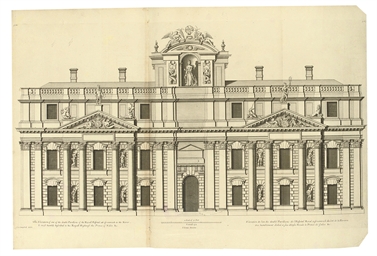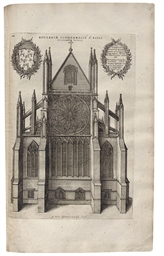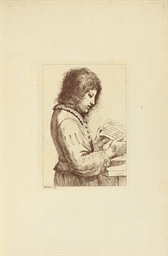SHAW, George (1751-1813). Musei Leveriani explicatio... Museum Leverianum containing select specimens from the museum of Sir Ashton Lever . [London:] James Parkinson, 1792-1796.
SHAW, George (1751-1813). Musei Leveriani explicatio... Museum Leverianum containing select specimens from the museum of Sir Ashton Lever . [London:] James Parkinson, 1792-1796. 3 parts only (of 6), 4° (297 x 227mm). Latin and English titles to part I, drophead titles to parts II and III, text in Latin and English. 36 (of 72) hand-coloured engraved plates after Sarah Stone Philip Reinagle Charles Reuben Ryley (Edges of text leaves lightly dust-soiled.) Original purple boards, printed paper labels to upper boards, edges uncut, modern green cloth box, red leather label to spine (lightly worn, part II loose). FIRST PART OF THE FIRST EDITION OF THIS SCARCE RECORD of one of the most comprehensive natural history collections of eighteenth-century England, including contributions from Philip Reinagle and Sarah Stone The museum was founded by Sir Ashton Lever (1729-1788) and was initially based at his home, Alkrington Hall, near Manchester. In 1774, in an attempt to make the musem self-financing, Lever leased Leicester House in London (on the site of what is now Leicester Square), installed his collection, and in early 1775 opened the museum to the public, charging an admission fee of half a guinea. In spite of the museum's enormous popularity, Sir Ashton was forced to sell off the museum in 1784 to recoup the money he had spent on his many acquisitions for it. The collection of 28,000 items had been valued at £53,000 in 1783 when the British Museum turned down the collection, but Parliament agreed to allow Lever to sell the collection by public lottery. Lever printed 36,000 tickets (to be sold at 1 guinea each). The lottery was held on 24 March 1784 (by which time Lever had sold 8,000 tickets); five weeks later James Parkinson produced the winning ticket, explaining that his wife had purchased the ticket without his knowledge, had subsequently died, and that he had only just found the ticket amongst her papers. Parkinson proved himself to be adept at advertising the museum and retaining the public's interest - the present work constitutes perhaps the most lasting aspect of his entrepreneurial spirit - but, despite all his efforts, he was eventually forced to break it up and sell it by auction. The sale lasted sixty-five days between 5 May and 19 July 1806; the majority of the bird specimens were bought by Lord Stanley of Knowsley Park. The majority of the plates in the present work are after the drawings by Charles Reuben Ryley (1752-1798), a highly talented illustrator, engraver and history painter who had won a Royal Academy gold medal in 1780 and decorated Goodwood House for the Duke of Richmond, but subsequently developed a taste for the high life, which led to him having to teach and illustrate books to support himself. Sarah Stone's work is represented by two images ( The Rock Manakin and The Splendid Parrot facing p.13 & p. 27 part I respectively). Philip Reinagle who was to later work with Thornton on his Temple of Flora , supplied seven images. Cf. Christine Jackson. Sarah Stone , 1998 (includes a full account of the Leverian Museum). Fine Bird Books (1990) p.142; Nissen ZBI 3835; Wood 566. (3)
SHAW, George (1751-1813). Musei Leveriani explicatio... Museum Leverianum containing select specimens from the museum of Sir Ashton Lever . [London:] James Parkinson, 1792-1796.
SHAW, George (1751-1813). Musei Leveriani explicatio... Museum Leverianum containing select specimens from the museum of Sir Ashton Lever . [London:] James Parkinson, 1792-1796. 3 parts only (of 6), 4° (297 x 227mm). Latin and English titles to part I, drophead titles to parts II and III, text in Latin and English. 36 (of 72) hand-coloured engraved plates after Sarah Stone Philip Reinagle Charles Reuben Ryley (Edges of text leaves lightly dust-soiled.) Original purple boards, printed paper labels to upper boards, edges uncut, modern green cloth box, red leather label to spine (lightly worn, part II loose). FIRST PART OF THE FIRST EDITION OF THIS SCARCE RECORD of one of the most comprehensive natural history collections of eighteenth-century England, including contributions from Philip Reinagle and Sarah Stone The museum was founded by Sir Ashton Lever (1729-1788) and was initially based at his home, Alkrington Hall, near Manchester. In 1774, in an attempt to make the musem self-financing, Lever leased Leicester House in London (on the site of what is now Leicester Square), installed his collection, and in early 1775 opened the museum to the public, charging an admission fee of half a guinea. In spite of the museum's enormous popularity, Sir Ashton was forced to sell off the museum in 1784 to recoup the money he had spent on his many acquisitions for it. The collection of 28,000 items had been valued at £53,000 in 1783 when the British Museum turned down the collection, but Parliament agreed to allow Lever to sell the collection by public lottery. Lever printed 36,000 tickets (to be sold at 1 guinea each). The lottery was held on 24 March 1784 (by which time Lever had sold 8,000 tickets); five weeks later James Parkinson produced the winning ticket, explaining that his wife had purchased the ticket without his knowledge, had subsequently died, and that he had only just found the ticket amongst her papers. Parkinson proved himself to be adept at advertising the museum and retaining the public's interest - the present work constitutes perhaps the most lasting aspect of his entrepreneurial spirit - but, despite all his efforts, he was eventually forced to break it up and sell it by auction. The sale lasted sixty-five days between 5 May and 19 July 1806; the majority of the bird specimens were bought by Lord Stanley of Knowsley Park. The majority of the plates in the present work are after the drawings by Charles Reuben Ryley (1752-1798), a highly talented illustrator, engraver and history painter who had won a Royal Academy gold medal in 1780 and decorated Goodwood House for the Duke of Richmond, but subsequently developed a taste for the high life, which led to him having to teach and illustrate books to support himself. Sarah Stone's work is represented by two images ( The Rock Manakin and The Splendid Parrot facing p.13 & p. 27 part I respectively). Philip Reinagle who was to later work with Thornton on his Temple of Flora , supplied seven images. Cf. Christine Jackson. Sarah Stone , 1998 (includes a full account of the Leverian Museum). Fine Bird Books (1990) p.142; Nissen ZBI 3835; Wood 566. (3)















Testen Sie LotSearch und seine Premium-Features 7 Tage - ohne Kosten!
Lassen Sie sich automatisch über neue Objekte in kommenden Auktionen benachrichtigen.
Suchauftrag anlegen